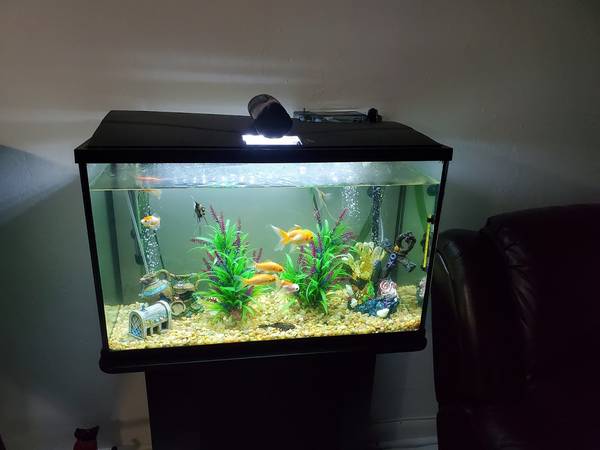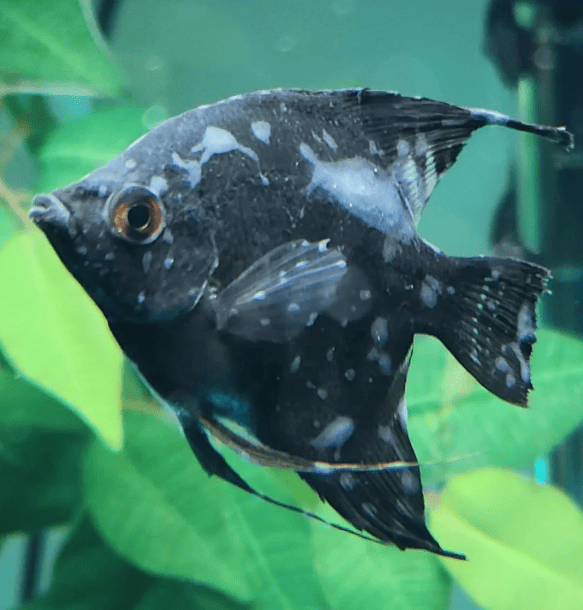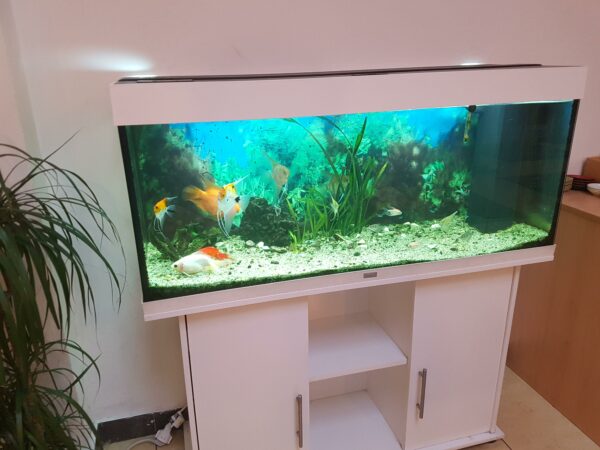[ad_1]
Owing to misconception and lack of information, many beginner aquarium enthusiasts keep angelfish and goldfish together. Although we’ve seen them flourish together in healthy waters, most of them experience a dreadful life and a painful death.
Both environmentally and behaviorally, angelfish and goldfish are different. While one is a monk, the other is a toddler. Given enough space, you can keep them together, but it’s often a challenge to understand their species-wise requirements.
In this article, we’ll discuss whether your angelfish can live with goldfish and, if necessary, how you can keep them together.
Can Angelfish Live with Goldfish?
No, angelfish shouldn’t live with goldfish. A few fundamental requirements like water temperature, water parameters, and aggression may contribute to both their discomfort and limit their growth.
Let’s discuss them in detail.
Temperature Requirements
Angelfish and Goldfish have different temperature requirements when it comes to having a healthy life. Being cold-blooded creatures, their body temperature adjusts to that of their environment. Their bodily functions are optimized for the specific temperature range.
The optimum water temperature for angelfish to thrive is between 75 to 82F. However, they can withstand a few degrees of deviation without any issues.
On the other hand, goldfish require a temperature of 65 to 72F to flourish. They also can withstand a few degrees of deviation easily.
The lack of interception between these two temperature ranges requires you to keep those two species separate. Given the same, there is no one temp value that can sustain both angelfish and goldfish.
Other Water Parameters
Numerous different water parameters contribute to the overall health of your angelfish and goldfish. While some of the elements, like ammonia, nitrite, and nitrate, are best to be kept near zero, the other elements mentioned below are needed in a specific range.
Dissolved oxygen, although an essential parameter, doesn’t harm if it isn’t provided dangerously high or low. Keeping a steady supply often is enough to sustain both species.
pH Level
pH levels determine the acidity and basicity of the aquatic system. External pH influences the internal balance of goldfish, angelfish, and all other aquatic creatures. Significant pH deviation from the preferred range can disrupt their natural balance and lead to stress, organ dysfunction, and death.
The preferred pH level for angelfish is 6.5 to 7.5, while the preferred pH level for goldfish is 7.0 to 8.4. This indicates that angelfish prefers to live in a slightly acidic environment, and the goldfish thrive in a basic environment.
While the numbers may not seem drastically distant, Values below and above 7 differ in both characteristics and reactions.
Hardness
Goldfish require a high amount of calcium to maintain their skeletal structure and balance, therefore needing 140 to 200 ppm of hardness. On the other hand, angelfish prefers a hardness between 70 to 140 ppm.
Osmoregulation is the mechanism to regulate the balance of water and salts in the body. Fishes have specialized cells to facilitate that. The balance of mineral content such as calcium, chloride, and sodium in the water plays a significant role in the process.
Water hardness also contributes to the reproduction and egg development process of the species. Through our experience, we’ve seen many healthy breeding pairs stop laying eggs upon a change in water hardness.
Tank Size
There aren’t any upper limits on tank sizes when it comes to aquarium settings. However, assuming you’re a beginner enthusiast, you may not have access to larger tanks.

A larger tank is required mainly for 4 reasons:
Swimming space
Angelfish are vertical swimmers and require at least 20 gallons tank for a pair of Pearl Scales and Platinums. As they are fast swimmers and can hurt themselves if not given enough space, it’s better to offer them as much space as possible.
Size accommodation
Goldfish are plumper and larger than angelfish and require 20 gallons tank for a single Oranda or Fantain to thrive. For larger species or to build a goldfish colony, you need even bigger tanks. Depending on the swimming behavior of your goldfish species, maintain the ratio.
Waste management
Goldfish are notorious feeders and poopers. Angelfish, on the other hand, don’t make as much ammonia and nitrite as goldfish. To ensure adequate filtration and balance, a bigger tank is necessary to keep goldfish alive and well.
Keeping goldfish in the same tank increases the toxicity of the water and jeopardizes the livelihood of the angelfish.
Competition
During breeding or when establishing hierarchy, angelfish can become a bit territorial and try to stand their ground. Thanks to an overzealous and exploring nature, goldfish can ram into the territory of an angelfish.
This, ultimately, can harm the angelfish due to their differences in size and strength. While a large tank may resolve the issue, it’s better to keep them separate.
Natural Behavior
Both goldfish and angelfish are pretty calm in nature. However, they have a few fundamental behavioral differences that make them bad tank mates.
To start, angelfish are graceful swimmers who effortlessly navigate the waters and don’t like to be bothered. In comparison, goldfish are sloppy and playful. They exhibit shoaling behavior and may want to include your angelfish in their social circle, despite their lack of interest.
Goldfish also love to nibble on decorations and other fish in the tank, which can make your angelfish uneasy and stressed. If agitated, angelfish can also harm the goldies by nibbling on their fins.
Moreover, angelfish are hunters, while goldfish are gatherers. Angelfish can mistake the eye sacs or fins of your goldfish for food and attack them.
Water Movement
Angelfish are native to the Amazon Basin—preferring a gentle to moderate water flow to swim through. Strong turbulent water current that doesn’t replicate their natural habitat can cause stress and physical strain to them. You have to adjust your filters to a suitable setting before setting an angelfish tank.
Goldfish, on the other hand, are capable of adapting to varying water flow rates. They even prefer to have localized turbulence to play in. You can generate it through powerheads. However, they don’t necessarily need a strong water movement to thrive.
Additionally, goldfish fins are pretty fragile to handle very strong currents.
Diet Difference
Diet is one of the most critical reasons why your angelfish can’t live with goldfish. Most beginner enthusiasts make a similar mistake by feeding both species the same pellets and flakes.
Goldfish are mainly omnivorous, meaning they eat both animal and plant-based food. High-quality pellets designed for goldfish are appropriate for them, with occasional dried shrimp and veggies.
On the other hand, angelfish are carnivorous, and their diet usually includes small invertebrates and insect larvae. The digestive systems of these species are adapted to different diets. Forcing angelfish to eat veggies or goldfish pellets or forcing goldfish to eat larvae consistently can cause diarrhea, fatigue, and death.
How Can I Keep My Angelfish with Goldfish?

In an emergency, if you must keep your angelfish with goldfish, follow the steps mentioned below. Remember, these steps are integral and don’t work if you fail to follow a single item on the list.
Adjust pH levels accordingly
Angelfish and goldfish have different pH requirements. As there are no common grounds to adjust your aquarium pH levels, we recommend either keeping it neutral to 7 or trying to stay lenient towards the preference of angelfish.
Keeping a neutral pH throughout can become challenging as any changes in the water chemistry, even temperature, can tip the scale. However, as angelfish are more sensitive to water parameter changes, it’s better to stay on the acidic side.
To lower your aquarium pH, gradually introduce:
- pH-buffering substrates like peat moss or driftwood.
- Acid buffers
- Mix RO water with normal tap water.
To increase aquarium pH:
- Use crushed coral or limestone.
- Use baking soda in moderation.
- Use commercial pH accelerators.
Adjust water temperature
Again, goldfish can withstand temperatures a few degrees over their normal preference. Therefore, if you must keep angelfish with your goldfish, ensure that the water temperature is around 75 to 80F.
Increasing the temperature a few degrees shouldn’t be an issue with a thermostat. However, here is how you can decrease water temperature if it’s too hot outside.
- Adjust the room temperature by opening windows, air conditioning, or by using fans. It’ll reduce the overall temperature of your aquarium.
- Reduce heat sources and lighting, especially bright light near the water level. Avoid keeping the aquarium against direct sunlight.
- Increase airflow and evaporation by using a fan to blow across the surface. Ensure uninterrupted evaporation by removing the cover.
- Although uncommon, aquarium chillers are commercial portable devices that are used to cool water temperatures.
- Frozen ice packs.
Strike a mineral balance
Before we discuss the essential minerals and their purpose, you may keep the water hardness level between 100-120 ppm for the emergency combined tank.
Calcium
For angelfish, calcium is required to strengthen bones and their bristle-like teeth. Similarly, calcium is important for goldfish to maintain healthy bones, scales, and pharyngeal teeth.
Magnesium
In angelfish, magnesium contributes to enzyme function, metabolism, and muscle contraction. Goldfish don’t require magnesium as much.
Potassium
Potassium regulates fluid balance, nerve function, and muscle movement in angelfish.
Phosphorus
Phosphorus is essential for energy metabolism, bone development, and overall growth in goldfish.
Sodium
Sodium is involved in maintaining osmotic balance and regulating fluid levels in goldfish.
Trace Minerals
Iron, zinc, and copper are essential trace minerals for both goldfish and angelfish.
Get a bigger tank
According to the previous estimations, get yourself a bigger tank if you’re planning to keep angelfish and goldfish together. In this regard, consider what your goldfish may need and match their requirements.

The tank volume suitable for angelfish may not be enough for the goldfish to survive. Here is a brief calculation for you to understand:
To calculate the number of gallons in a rectangular aquarium, you need to know the dimensions of the tank in inches (length, width, and height).
Here’s the formula:
Gallons = (Length × Width × Height) / 231
For example, if the length of the tank is 24 inches, the width is 12 inches, and the height is 16 inches, the calculation would be:
Gallons = (24 × 12 × 16) / 231
Gallons = 4608 / 231
Gallons = 19.93 gallons
So, in this example, the rectangular aquarium would hold approximately 19.93 gallons of water.
Get appropriate decorations
Cater to both your angelfish and goldfish with decorations that suit their needs. Being territorial and shy, angelfish prefer decorations that offer hiding spots.
On the other hand, goldfish are more lenient towards decorations that allow exploration and scavenging.
Decorations for angelfish:
- Driftwood: Found in their natural habitat, angelfish prefer hiding in the safety of driftwood.
- Live plants: Angelfish love having live plants like Amazon Sword, Anubis, and Java fern in the aquarium.
- Rocks and caves
Creating additional hiding spots, rocks, and caves are decorations great for angelfish.
Decoration for goldfish:
Goldfish scavenge and explore the smooth rocks to fulfill their visual and investigative interest.
Goldfish may nibble on live plants to uproot them.
Give your goldfish enough space to swim around and socialize.
Also Check out our article on ‘Can Guppies And Goldfish Live Together?’.
FAQ
In addition to goldfish, small fin-nipping fish like tetras and barbs can cause stress by poking their flowing fins. Larger cichlids may also cause injury to angelfish. Very small fish like shrimp may also get devoured by angelfish.
While not common, goldfish can eat other small fish by accident. Small shrimp and bottom-dwellers are the most common victims of such practice. Even if they survive, they can get injured pretty badly.
Good tank mates for angelfish are:
– Dwarf Gourami
– Praecox Rainbow Fish
– Zebra Loaches
– Platies
– Mollies
– Boesemani Rainbow Fish
The Bottom Line
We’ve tried to give you the most detailed and comprehensive guide about keeping angelfish and goldfish together. While they should always be kept separately, we also have considered emergencies and necessary steps that you must take to ensure the safety of your fish.
Pro Tip: When in doubt, go with the angelfish requirements. Goldfish are more resilient to water changes than angelfish.
[ad_2]
Source link
